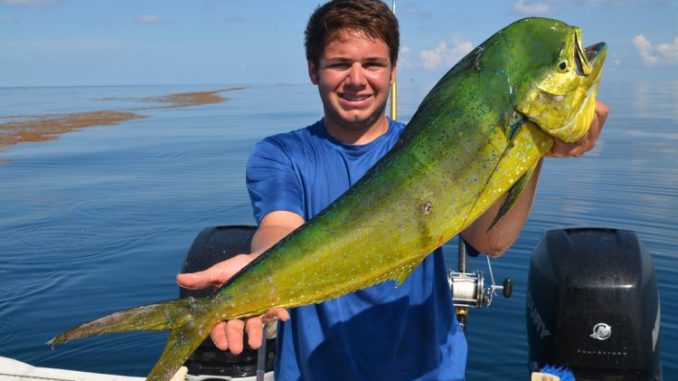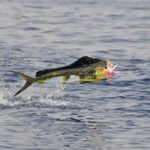
If ever a motto could be used to describe a fish, this one describes the dolphin, the riotously-colored, hyperkinetic, blue-water fish that Hawaiians aptly call mahi-mahi, which translates out as “strong-strong.”
The fish is very familiar to anyone who fishes offshore, but few know that the fish we call dolphin is two species rather than one. The most common and most familiar is the one simply known as the dolphinfish (Coryphaena hippurus). The lesser-known species is the pompano dolphinfish (Coryphaena equiselis).
The origins of the scientific names for the two species is unspectacular, with Coryphaena being taken from “koryphaina,” the Greek name for dolphinfish. Both hippurus and supposedly equiselis refer to “horse” in Latin.
Most scholars seem to agree that the name “equiselis” was a misspelling of “equisetis” by the great scientist Carl Linnaeus when he named the fish in 1758. In Latin, equisetis does indeed mean horse, while equiselis means absolutely nothing, but in the rules of scientific naming, the original name stands.
Both species of dolphin are found in a wide belt of tropical and subtropical waters on both sides of the equator around the entire globe. They are similarly colored, shading from a brilliant green on their backs to eye-scorching yellow on their flanks and bellies. These colors are overlain by liberal doses of sky-blue specks and spots.
Many references state that the two are easy to tell apart, in spite of being virtually identically colored. Few fishermen are going to count dorsal fin rays or vertebrae to tell one from another.
The pompano dolphin does have a deeper body relative to its length than does the dolphinfish. But unless the angler has one of each at hand to compare, it is difficult to separate the two.
The simplest way is with a quick inspection of the tooth patch on the tongue. It is square and covers most of the width of the tongue in a pompano dolphin. In the dolphinfish, it is oval and covers half the width of the tongue. Generally speaking, the pompano dolphin is also the most oceanic of the two and found further from shore.
Both species share a common trait. They burn through their lives at a ferocious pace. They may be the only fish that scientists can easily measure their growth rate per day, not per year or even per month, but per day.
When young, dolphinfish grow at a rate of 5 inches per month, topping out at a maximum size of 5 feet long in 2 years. Then they die. While the maximum life span is sometimes given as 4 years, other scientists estimate that 100 percent of Gulf of Mexico dolphin die by 2 years old.
Thirty-pound bull (male) dolphin are not uncommon. It’s mind-boggling that such fish may only be a year or a year-and-a-half old. The IGFA world record is 87 pounds and the Louisiana record is 71 pounds.
That kind of growth rate doesn’t come easy; dolphin are eating machines from hatching on. Away from the bottom, the blue waters of the ocean are almost a biological desert (that’s why they are so transparent and blue). They provide very little to eat compared to the same volume of green water found nearer the coast.
But blue water is where dolphin live. To find adequate food supplies, they haunt the biologically-rich sargassum weed beds and rip lines, which create their own ever-moving ecosystem.
Sargassum beds are home to the larvae and juveniles of big game fish such as tunas, billfishes, jacks, and mackerels, as well as bottomfish such as grunts, triggerfish, and filefish. For bottom-spawning triggerfish, their young are totally dependent upon surface-drifting sargassum.
Dolphin gorge on all these creatures, as well as adult and young flying fish. One study indicated that flying fish made up 25 percent of their diet, by weight. Dolphin also eat shrimp and crabs, both of which are found in sargassum, as well as squid and jellyfish.
Their active lifestyle burns a lot of energy and demands a lot of oxygen. They swim constantly to force oxygenated water over their oversized gills. Maximum swimming speed is over 50 miles per hour.
Males seem to be more active feeders as more food is usually found in their stomachs. They also grow substantially larger than females and mature males develop prominent, steeply sloping foreheads. Females’ heads remain more rounded in profile, similar to juvenile fish.
In keeping with their frenetic lifestyle, both males and females become sexually mature a mere 4 to 5 months after being spawned. Females may only be 8 inches long at their first spawning. Rather than spawning in groups, dolphins pair off for their romance.
Dolphin spawn several times a year. In the tropics, spawning takes place year-round. In cooler, subtropical waters like the Gulf of Mexico, spawning only takes place in the summer. A small female may only produce 80 thousand eggs per spawn. Very large females will lay 1.5 million eggs each spawn.
Fishermen catch more females than males. Small dolphin of both sexes and adult females spend more time around floating objects and seaweed beds and are therefore easier for anglers to locate and catch. Large mature males (bulls) spend more time in open water, traveling between the female-dominated schools near floating cover.
As dashing as dolphinfish are, they are not the top predator on sargassum rips. In the Atlantic, yellowfin and albacore tunas, as well as marlin and perhaps sailfish are dolphin predators.
Dolphinfish are commonly seen with holes punched through them by marlin bills. Swordfish, sharks, porpoises, and even sea birds have also been known to prey on dolphins.




